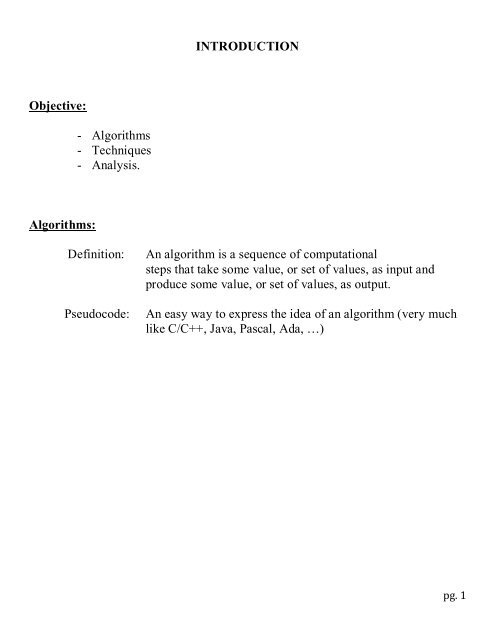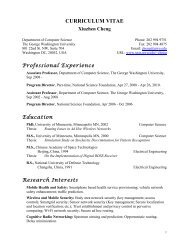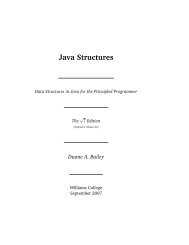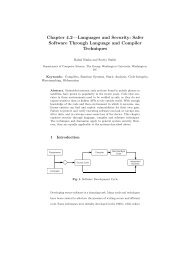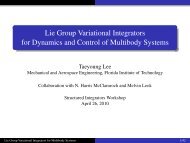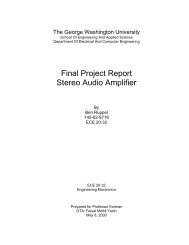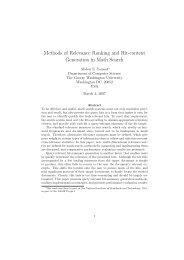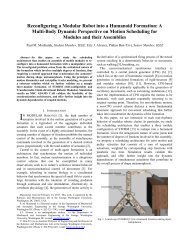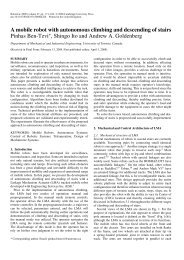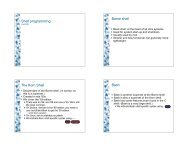Introduction: Basic principles of algorithm design and analysis ...
Introduction: Basic principles of algorithm design and analysis ...
Introduction: Basic principles of algorithm design and analysis ...
You also want an ePaper? Increase the reach of your titles
YUMPU automatically turns print PDFs into web optimized ePapers that Google loves.
INTRODUCTION<br />
Objective:<br />
- Algorithms<br />
- Techniques<br />
- Analysis.<br />
Algorithms:<br />
Definition:<br />
Pseudocode:<br />
An <strong>algorithm</strong> is a sequence <strong>of</strong> computational<br />
steps that take some value, or set <strong>of</strong> values, as input <strong>and</strong><br />
produce some value, or set <strong>of</strong> values, as output.<br />
An easy way to express the idea <strong>of</strong> an <strong>algorithm</strong> (very much<br />
like C/C++, Java, Pascal, Ada, …)<br />
pg. 1
Techniques<br />
Divide <strong>and</strong> Conquer<br />
The greedy method<br />
Dynamic programming<br />
Backtracking<br />
Branch <strong>and</strong> Bound<br />
pg. 2
Analysis <strong>of</strong> Algorithms<br />
Motivation:<br />
Estimation <strong>of</strong> required resources such as memory space, computational<br />
time, <strong>and</strong> communication b<strong>and</strong>width.<br />
Comparison <strong>of</strong> <strong>algorithm</strong>s.<br />
Model <strong>of</strong> implementation:<br />
Cost:<br />
One-processor RAM (r<strong>and</strong>om-access machine) model.<br />
Single operations, such arithmetic operations & comparison operation, take<br />
constant time.<br />
Time complexity:<br />
total # <strong>of</strong> operations as a function <strong>of</strong> input size, also called running<br />
time, computing time.<br />
Space complexity:<br />
total # memory locations required by the <strong>algorithm</strong>.<br />
pg. 3
Asymptotic Notation<br />
Objective:<br />
What is the rate <strong>of</strong> growth <strong>of</strong> a function?<br />
What is a good way to tell a user how quickly or slowly an<br />
<strong>algorithm</strong> runs?<br />
Definition:<br />
A theoretical measure <strong>of</strong> the comparison <strong>of</strong> the execution <strong>of</strong> an<br />
<strong>algorithm</strong>, given the problem size n, which is usually the<br />
number <strong>of</strong> inputs.<br />
To compare the rates <strong>of</strong> growth:<br />
Big-O notation: Upper bound<br />
Omega notation: lower bound<br />
Theta notation: Exact notation<br />
1- Big- O notation:<br />
pg. 4
Definition: f(n)= O(g(n)) if there exist positive constants c n 0 such<br />
that f(n)c*g(n) when n n 0<br />
g(n) is an upper bound <strong>of</strong> f(n).<br />
Examples:<br />
f(n)= 3n+2<br />
What is the big-O <strong>of</strong> f(n)?<br />
f(n)=O(?)<br />
For 2n<br />
3n+23n+n=4n<br />
f(n)= 3n+2 4n f(n)=O(n)<br />
Where c=4 <strong>and</strong> n 0 =2<br />
f(n)=62 n +n 2<br />
What is the big-O <strong>of</strong> f(n)?<br />
f(n)=O(?)<br />
For n 2 2 n is true only when n4<br />
62 n +n 2 62 n +2 n =7*2 n<br />
c=7 n 0 =4 f(n) 7*2 n<br />
f(n)= O(2 n )<br />
Theorem: If f(n)= a m n m + a m-1 n m-1 +...+ a 1 n+a 0<br />
pg. 5
Pro<strong>of</strong>:<br />
m<br />
f(n) <br />
i0<br />
m<br />
i<br />
= a<br />
in<br />
i0<br />
Then f(n)= O(n m )<br />
a<br />
i<br />
i n<br />
m<br />
n m * <br />
i0<br />
a<br />
im<br />
i n<br />
Since n i-m 1 |a i | n i-m |a i |<br />
m<br />
<br />
i0<br />
im<br />
i n<br />
m<br />
a a<br />
i0<br />
i<br />
m<br />
f(n) n m * <br />
i0<br />
a<br />
i<br />
for n1<br />
f(n) n m * c<br />
m<br />
where c= <br />
i0<br />
a<br />
i<br />
f(n)= O(n m )<br />
O(log n) < O(n) < O(n log n) < O(n 2 ) < O(n 3 ) < O(2 n )<br />
2- Omega notation:<br />
Definition:<br />
f(n)= (g(n)) if there exist positive<br />
constant c <strong>and</strong> n 0 s.t.<br />
f(n) cg(n) For all n, n n 0<br />
pg. 6
g(n) is a lower bound <strong>of</strong> f(n)<br />
Example:<br />
f(n)=3n+2<br />
Since 2 0 3n+2 3n for n 1<br />
Remark that the inequality holds also for n 0, however the<br />
definition <strong>of</strong> requires no > 0<br />
c=3 , n 0 =1 f(n) 3n<br />
f(n)= (n)<br />
Theorem: If f(n)= a m n m + a m-1 n m-1 +...+ a 1 n+a 0<br />
m<br />
i<br />
= a in <strong>and</strong> am > 0<br />
i0<br />
Then f(n)= (n m )<br />
Pro<strong>of</strong>:<br />
a<br />
f(n)= a m n m 1 m<br />
[1 <br />
m-1<br />
n ... <br />
0<br />
n ]<br />
am<br />
am<br />
= a m n m <br />
a<br />
For a very large n, let's say n 0 , 1<br />
f(n) = a m n m a m n m<br />
f(n)= ( n m )<br />
3- Theta notation:<br />
Definition: f(n)= (g(n)) if there exist positive constants c1, c2, <strong>and</strong><br />
n 0 s.t. c1g(n) f(n) c2g(n) for all n n 0<br />
g(n) is also called an exact bound <strong>of</strong> f(n)<br />
pg. 7
Example1:<br />
f(n)= 3n+2<br />
We have shown that f(n) 4n f(n) 3n<br />
3n f(n) 4n<br />
c1=3, c2=4, <strong>and</strong> n 0 =2<br />
f(n)= (n)<br />
Example2:<br />
n<br />
k<br />
f(n) = i<br />
i0<br />
Show that f(n)= (n k+1 )<br />
Pro<strong>of</strong>:<br />
n<br />
k<br />
f(n)= <br />
i0<br />
f(n)= O(n k+1 )<br />
i <br />
n<br />
k<br />
n = n * n k = n k+1<br />
i0<br />
n<br />
k<br />
f(n) = i<br />
i0<br />
n n n<br />
= 1 2<br />
k<br />
... ( 1)<br />
k<br />
( )<br />
k<br />
( 1)<br />
k<br />
... n<br />
k<br />
2 2 2<br />
= +<br />
where<br />
=<br />
n n<br />
1<br />
2<br />
k<br />
... ( 1)<br />
k<br />
( )<br />
k<br />
2 2<br />
pg. 8
=<br />
n<br />
( 1)<br />
k<br />
... n<br />
k<br />
2<br />
=<br />
n<br />
( 1)<br />
k<br />
... n<br />
k<br />
2<br />
n n n<br />
( )<br />
k<br />
... ( )<br />
k<br />
( )<br />
2 2 2<br />
k n<br />
*<br />
2<br />
f(n) <br />
n k n n<br />
k1<br />
( ) * =<br />
2 2 2<br />
k1<br />
f(n) (n k+1 )<br />
( n k+1 ) f(n) O(n k+1 )<br />
<br />
f(n)= (n k+1 )<br />
pg. 9
Summary:<br />
pg. 10
4. Properties:<br />
Let<br />
T1(n)= O(f(n))<br />
T2(n)= O(g(n))<br />
1- The sum rule:<br />
If T(n)= T1(n)+ T2(n)<br />
Then T(n)= O( max (f(n),g(n) )<br />
Example:<br />
T(n)= n 3 +n 2 T(n)= O(n 3 )<br />
2- The product rule:<br />
If T(n)= T1(n) T2(n)<br />
Then T(n)= O( f(n)g(n) )<br />
Example:<br />
T(n)= n n T(n)= O(n 2 )<br />
3- The scalar rule:<br />
If T(n)= T1(n) k where k is a constant,<br />
Then T(n)= O( f(n) )<br />
Example:<br />
T(n)= n 2 2<br />
1 T(n)= O(n 2 )<br />
pg. 11
Be careful<br />
Which is better F(n)=6n 3 or G(n) = 90n 2<br />
F(n)/G(n)= 6n 3 /90n 2 =6n/90 =n/15<br />
Case1:<br />
n 90n 2<br />
G(n) is better.<br />
pg. 12
Complexity <strong>of</strong> a Program<br />
Time Complexity:<br />
Comments:<br />
Declaration:<br />
Expressions assignment statements:<br />
no time.<br />
no time.<br />
1 time unit a O(1)<br />
Iteration statements:<br />
For i= exp1 toexp2 do<br />
Begin<br />
Statements<br />
End;<br />
// For Loop takes exp2-exp1+1 iterations<br />
While exp do is similar to For Loop.<br />
Space complexity<br />
The total <strong>of</strong> memory locations used in the declaration part :<br />
Single variable: O(1)<br />
Arrays (n:m) : O(nxm)<br />
In addition to that, the memory needed for execution (Recursive programs).<br />
Total <strong>of</strong> 5n + 5 ; therefore O(n) ;<br />
PROCEDURE bubble (VAR a: array_type ) ;<br />
VAR i , j , temp : INTEGER ;<br />
pg. 13
BEGIN<br />
1 FOR i := 1 TO n-1 DO<br />
2 FOR j := n DOWN TO i DO<br />
3 IF a[ j-1 ] > a [ j ] THEN BEGIN<br />
{swap}<br />
4 temp := a [j-1];<br />
5 a [j-1] := a [j] ;<br />
6 a [j] := temp<br />
END<br />
END ( bubble ) ;<br />
Line 4,5,6 O (max (1,1,1) ) = O (1)<br />
move up line 3 to 6 still O(1)<br />
move up line 2 to 6 O( (n-i) 1 ) = O (n-i)<br />
move up line 1 to 6;<br />
(n-i) = n - i = n 2 - (n-1)n/2 = n 2- n 2 /2 - n/2 O(n 2 )<br />
Later we will see how change it to O(n log n)<br />
Seven computing times are : O(1) ; O( log n) ;O(n); O(n log n); O(n 2 ); O(n 3 );<br />
O(2 n )<br />
control := 1 ;<br />
WHILE control n LOOP<br />
…….<br />
something O(1)<br />
control := 2 control ;<br />
END LOOP ;<br />
control := n ;<br />
WHILE control >= 1 LOOP<br />
…….. O(log n)<br />
something O(1)<br />
control := control /2 ; control integer<br />
END LOOP ;<br />
pg. 14
FOR count = 1 to n LOOP<br />
control := 1 ;<br />
WHILE control n LOOP<br />
…… …….. O(n log n)<br />
something O(1)<br />
control := 2 control ;<br />
END LOOP ;<br />
END LOOP ;<br />
FOR count = 1 to n LOOP<br />
control := count;<br />
WHILE control >= 1 LOOP<br />
…… ……..<br />
something O(1)<br />
control := control div 2;<br />
END LOOP ;<br />
END LOOP ;<br />
pg. 15
Amortized <strong>analysis</strong>:<br />
Definition:<br />
It provides an absolute guarantees <strong>of</strong> the total time taken by a<br />
sequence <strong>of</strong> operations. The bound on the total time does not refleth the time<br />
required for any individual operation, some single operations may be very<br />
expensive over a long sequence <strong>of</strong> operations, some may take more, some may take<br />
less.<br />
Example:<br />
Given a set <strong>of</strong> k operations. If it takes O(k f(n) ) to perform the k<br />
operations then we say that the amortized running time is O (f(n) ).<br />
pg. 16
Pseudocode Conventions<br />
Variables Declarations<br />
Integer X,Y;<br />
Real Z;<br />
Char C;<br />
Boolean flag;<br />
Assignment<br />
X= expression;<br />
X= yx+3;<br />
Control Statements<br />
If condition:<br />
Then<br />
A sequence <strong>of</strong> statements.<br />
Else<br />
A sequence <strong>of</strong> statements.<br />
Endif<br />
For loop:<br />
For I= 1 to n do<br />
Sequence <strong>of</strong> statements.<br />
Endfor;<br />
While statement:<br />
While condition do<br />
Sequence <strong>of</strong> statements.<br />
End while.<br />
Loop statement:<br />
Loop<br />
Sequence <strong>of</strong> statements.<br />
Until condition.<br />
Case statement:<br />
Case:<br />
Condition1: statement1.<br />
Condition2: statement2.<br />
Condition n: statement n.<br />
Else : statements.<br />
End case;<br />
Procedures:<br />
pg. 17
Procedure name (parameters)<br />
Declaration<br />
Begin<br />
Statements<br />
End;<br />
Functions:<br />
Function name (parameters)<br />
Declaration<br />
Begin<br />
Statements<br />
End;<br />
pg. 18
Recursive Solutions<br />
Definition:<br />
o A procedure or function that calls itself, directly or indirectly, is<br />
said to be recursive.<br />
Why recursion?<br />
o For many problems, the recursion solution is more natural than<br />
the alternative non-recursive or iterative solution<br />
o It is <strong>of</strong>ten relatively easy to prove the correction <strong>of</strong> recursive<br />
<strong>algorithm</strong>s (<strong>of</strong>ten prove by induction).<br />
o Easy to analyze the performance <strong>of</strong> recursive <strong>algorithm</strong>s. The<br />
<strong>analysis</strong> produces recurrence relation, many <strong>of</strong> which can be<br />
easily solved.<br />
Format <strong>of</strong> a recursive <strong>algorithm</strong>:<br />
o Algorithm name(parameters)<br />
Declarations;<br />
Begin<br />
if (trivial case)<br />
then do trivial operations<br />
else begin<br />
end;<br />
end;<br />
- one or more call name(smaller values <strong>of</strong><br />
parameters)<br />
- do few more operations: process the sub-solution(s).<br />
pg. 19
Taxonomy:<br />
o Direct Recursion:<br />
• It is when a function refers to itself directly<br />
o Indirect Recursion:<br />
• It is when a function calls another function which refer to<br />
it.<br />
o Linear Recursion:<br />
• It is when one a function calls itself only once.<br />
o Binary Recursion:<br />
• A binary-recursive routine (potentially) calls itself twice.<br />
Examples<br />
o Find Max<br />
Function Max-set (S)<br />
Integer m 1 , m 2 ;<br />
Begin<br />
If the number <strong>of</strong> elements s <strong>of</strong> S=2<br />
Then<br />
Return (max(S(1), S(2)) );<br />
Else<br />
Begin<br />
Split S into two subsets; S 1 ,S 2 ;<br />
m 1 = Max-set (S 1 )<br />
m 2 = Max-set (S 2 )<br />
Return (max (m 1 ,m 2 ) );<br />
End;<br />
Endif<br />
End;<br />
pg. 20
o Printing a stack:<br />
• Recursive method to print the content <strong>of</strong> a stack<br />
Printing the stack<br />
Z<br />
C Z C B A<br />
B<br />
A<br />
public void printStackRecursive() {<br />
if (isEmpty())<br />
System.out.println("Empty Stack");<br />
else {<br />
System.out.println(top());<br />
pop();<br />
if (!isEmpty())<br />
printStackRecursive();<br />
}<br />
}<br />
o Palindrome:<br />
int function Palindrome(string X)<br />
Begin<br />
If Equal(S,StringReverse(S))<br />
then return TRUE;<br />
else return False;<br />
end;<br />
pg. 21
o Reversing a String:<br />
• Pseudo-Code:<br />
string function StringReverse(string S)<br />
/* Head(S): returns the first character <strong>of</strong> S */<br />
/* Tail(S): returns S without the first character */<br />
begin<br />
If (Length(S)
• Example 1:<br />
- The time complexity <strong>of</strong> StringReverse function:<br />
o Let T(n) be the time complexity <strong>of</strong> the function<br />
where n is the length <strong>of</strong> the string.<br />
o The recurrence relation is:<br />
- Solution:<br />
(B) n=1 let T(n)=1<br />
(R) n>1 let T(n)=T(n-1)+1<br />
T(n) = T(n-1)+1<br />
T(n-1) = T(n-2)+1<br />
T(n-2) = T(n-3)+1<br />
...<br />
T(3) = T(2)+1<br />
T(2) = T(1)+1<br />
T(n) = T(1)+1+1+1+...+1 = T(1)+(n-1) = n<br />
===> T(n) = O(n<br />
pg. 23
• Example 2:<br />
T ( n)<br />
<br />
<br />
<br />
<br />
<br />
<br />
2T<br />
(<br />
n<br />
) C<br />
2<br />
C<br />
if<br />
if<br />
n1<br />
n1<br />
Assume that n = 2 k<br />
T(n) = 2T(n/2)+C<br />
2T(n/2) = 2 2 T(n/4)+2C<br />
2 2 T(n/4) = 2 3 T(n/8)+ 2 2 C ...<br />
2 k-2 T(n/2 k-2 ) = 2 k-1 T(n/2 k-1 )+ 2 k-2 C<br />
2 k-1 T(n/2 k-1 ) = 2 k T(n/2 k )+ 2 k-1 C<br />
T(n) = 2 k T(1)+C+2C+2 2 C +...+2 k-2 C+2 k-1 C =<br />
T(n) = 2 k C +C(1+2+2 2 +...+2 k-2 +2 k-1 )<br />
k 1 k<br />
k<br />
T(n) = nC +C 2 i 2<br />
( 1)<br />
1<br />
1<br />
2<br />
<br />
2k<br />
i 0 21<br />
1<br />
<br />
<br />
T(n) = nC +C<br />
2<br />
( k 1)<br />
1<br />
1<br />
21<br />
T(n) = nC +C<br />
2 k<br />
1<br />
T(n) = nC +C 2 k<br />
T(n) = nC +nC=2nC<br />
==> T(n) =O(n)<br />
pg. 24
o Space Complexity:<br />
• Each recursive call requires the creation <strong>of</strong> an activation<br />
record<br />
• Each activation record contains the following:<br />
- Parameters <strong>of</strong> the <strong>algorithm</strong> (PAR)<br />
- Local variable (LC)<br />
- Return address (R @)<br />
- Stack link (SL)<br />
• Example:<br />
SL<br />
R @<br />
PAR<br />
LV<br />
SL<br />
R @<br />
PAR<br />
LV<br />
SL<br />
R @<br />
PAR<br />
LV<br />
Main Program: Local<br />
Variable<br />
- Complexity:<br />
o Let<br />
P: parameters<br />
pg. 25
Disadvantages:<br />
L: local variables<br />
2: SL <strong>and</strong> R @<br />
n: is the maximum recursive depth<br />
space= n*(P+L+2)<br />
o Recursive <strong>algorithm</strong>s require more time:<br />
• At each call we have to save the activation record <strong>of</strong> the<br />
current call <strong>and</strong> Branch to the code <strong>of</strong> the called procedure<br />
• At the exit we have the recover the activation record <strong>and</strong><br />
return to the calling procedure.<br />
• If the depth <strong>of</strong> recursion is large the required space may be<br />
significant.<br />
Exercises:<br />
o What is the time complexity <strong>of</strong> the following function:<br />
o What is the time complexity <strong>of</strong> the following function:<br />
o Write a recursive function that returns the total number <strong>of</strong> nodes<br />
in a singly linked list.<br />
Elimination <strong>of</strong> recursion<br />
pg. 26
The st<strong>and</strong>ard method <strong>of</strong> conversion is to simulate the stack <strong>of</strong> all the previous<br />
activation records by a local stack. Thus, assume we have a recursive <strong>algorithm</strong> F<br />
(p1,p2,….,pn) where pi are parameters <strong>of</strong> F.<br />
(1) Declare a local stack<br />
(2) Each call F (p1,p2,…..,pn) is replaced by a sequence to:<br />
(a) Push pi, for l i n, onto the stack.<br />
(b) Set the new value <strong>of</strong> each pi.<br />
(c) Jump to the start <strong>of</strong> the <strong>algorithm</strong>.<br />
(3) At the end <strong>of</strong> the <strong>algorithm</strong> (recursive), a sequence is added which:<br />
(a) Test whether the stack is empty, <strong>and</strong> ends if it is, otherwise,<br />
(b) Pop all the parameters from the stack.<br />
(c) Jump to the statement after the sequence replacing the call.<br />
Example:<br />
Procedure C (X: xtype)<br />
Begin<br />
If P(x) then M(x)<br />
Else<br />
Begin<br />
S1 (x)<br />
C (F(x) )<br />
S2 (x)<br />
End<br />
End<br />
Non-procedure C (X: xtype)<br />
Label 1,2 ;<br />
Var s: stack <strong>of</strong> x type<br />
Begin<br />
Clear s;<br />
1: if P(x) then M(x)<br />
else<br />
pg. 27
Begin<br />
S1(x) ; push x onto s ; x:= F(x);<br />
Goto 1;<br />
2: S2(x)<br />
end;<br />
if S is not empty then<br />
Begin<br />
pop x from s ;<br />
goto 2<br />
End;<br />
End {<strong>of</strong> procedure};<br />
pg. 28


